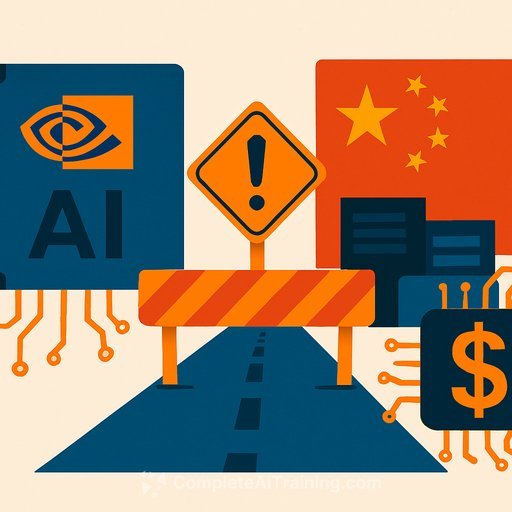Nvidia's China AI chip share drops from 95% to zero: what engineers need to do next
Nvidia's grip on China's advanced AI chip market has disappeared. CEO Jensen Huang says the company is barred from selling high-performance GPUs like the A100, H100, and H200 to Chinese buyers under U.S. export controls that began in 2022.
Huang warned that being shut out hands momentum to domestic rivals such as Huawei, as China accelerates self-sufficiency efforts. He also noted China's weight in global AI, citing that roughly half of the world's AI researchers are based there.
What changed
The U.S. expanded export controls on advanced computing and semiconductor items, effectively blocking Nvidia's flagship AI chips from China. For context, see the U.S. Commerce Department's Bureau of Industry and Security announcement on advanced computing controls here.
Nvidia attempted a workaround with the lower-spec H20 for China, but authorities reportedly opened a security review and local customers were told to steer clear. Separately, China's Cyberspace Administration reportedly told companies including ByteDance and Alibaba to stop buying Nvidia AI chips, including the RTX Pro 6000D server, according to the Financial Times.
Huang's message
"We will continue to explain and inform and hold on to hope for a change in policy," Huang said at a recent event. He cautioned that hurting China's access can also hurt the U.S., and added, "It's a mistake not to have those researchers build AI on American technology."
Why this matters for IT and development teams
- Procurement risk: Expect prolonged scarcity and higher total cost for compliant accelerators in cross-border projects.
- CUDA lock-in: Pure CUDA stacks face dead ends in China. Portability is now a hard requirement, not a preference.
- Vendor realignment: Domestic chips (e.g., Huawei) are gaining share. Toolchains, compilers, and kernels differ meaningfully.
- Compliance overhead: Contracts, data center locations, and cloud tenancy must reflect export rules.
- Performance variance: Expect different throughput/latency characteristics across NPUs/GPUs and more engineering to hit SLAs.
If you're building or operating in China
- Evaluate domestic accelerators: Test training and inference on available NPUs/GPUs. Focus on memory bandwidth, interconnect, and kernel maturity.
- Adopt portable stacks: Prioritize frameworks with multi-backend support (e.g., PyTorch + ONNX Runtime, OpenXLA, TVM). Keep custom kernels minimal and well-abstracted.
- Quantization first: Standardize INT8/FP8/weight-only paths to lower memory pressure and ease cross-hardware deployment.
- Model pragmatism: Prefer smaller, efficient architectures for on-prem or domestic cloud; reserve very large training for compliant regions.
- CI for kernels: Build automated perf and accuracy gates per backend to catch regressions when switching drivers or compilers.
If you're building outside China with China-adjacent users
- Dual-track architecture: Maintain a CUDA path (Nvidia) and a non-CUDA path (e.g., ROCm or vendor NPU) behind a common runtime API.
- Data and deployment boundaries: Separate training and inference regions. Use feature flags to swap model variants by region and hardware.
- Vendor diversification: Avoid single-supplier GPU contracts. Keep options open across clouds and on-prem.
- Export compliance as code: Encode policy checks into provisioning pipelines to block disallowed SKUs and regions.
Procurement and architecture checklist
- Inventory all CUDA dependencies; plan replacements or shims where needed.
- Standardize on ONNX export and a pluggable runtime layer for inference.
- Containerize drivers and toolchains per hardware target; pin versions.
- Benchmark with realistic tokens/sec and memory footprints, not just FLOPs.
- Renegotiate SLAs to reflect new hardware mixes and potential derates.
What to watch next
- Any BIS policy updates that widen/tighten controls.
- Huawei's AI chip roadmaps and cluster interconnect strategies.
- Domestic cloud offerings' throughput per dollar versus H100-class baselines.
- Toolchain maturity: compiler stability, kernel coverage, and debugging workflows.
If your team needs structured upskilling on cross-vendor AI engineering and deployment, explore role-based programs at Complete AI Training - courses by job and a curated index of popular AI tools.
Your membership also unlocks:






